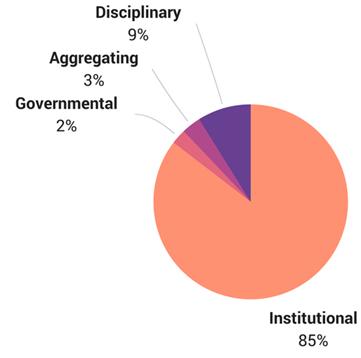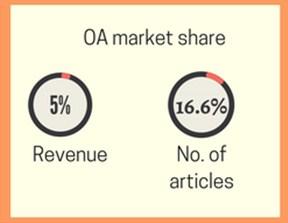
2 minute read
OA Repositories
Subject/Disciplinary Repositories
Open access repositories or archives are intended for researchers to contribute to the results of their research. Repositories or archives are organized by subject area or certain institutions maintain archives that cut across different disciplines. These repositories can house different types of content, namely articles, books, monographs, data, multimedia files (audio/video), conference proceedings, and more.
Advertisement
Usually, arXiv, bioRxiv, SSRN, RePEC, and PubMed Central are considered subject repositories. However, because of the development of effective search engines, changing publisher’s OA policy landscape, and emergence of institutional repositories have resulted in the slow growth of these subject repositories [10]. SciELO and Redalyc are not conventional repositories, but a database of bibliographies and digital library for OA journals

Subjects represented in OpenDOAR: Global Outlook (OpenDOAR Charts Worldwide [Internet]. 2017 [cited 20 July 2017]. Available from: http:// www.opendoar.org/find.php?format=charts)
OA REPOSITORIES
Institutional Repositories
These repositories are generally housed in a research institution or a university to store the research content generated by its members. These repositories not only provide open access to different versions of author’s manuscript but also act as a storage platform for dissertations, theses, technical reports, and e-learning materials. According to a study in 2013, 82% of the top 148 research institutes had institutional repertories that were capable to store 85% of the research output [10]. Maintaining such repertories helps universities to host research output and to present their prolific research environment. Interestingly, in a 2013 copyright study of 100 publishers, it was observed that immediate selfarchiving was allowed for 61% of the accepted articles in institutional repositories and only 21% in subject repositories [12].


OA REPOSITORIES
OpenDOAR, ROAR, and Aggregators
OpenDOAR (Directory of Open Access Repositories) is a directory for open access repositories, which helps in access and discovery of the OA repository and its content. As of 2017, it reports information of 3354 repositories [13].
OA Repository Types: Global Outlook
Region wise, Europe holds the biggest share (45%) of repositories followed by Asia (20%) and North America 918%) [13]. ROAR (Registry of Open Access Repositories) provides information on the growth and status of OA repositories. As of 2017, it provides information on 3838 repositories globally; of which, 1524 are In Europe, 917 in North America, and 795 in Asia [14]. On similar lines, ROARMAP (Registry of Open Access Repository Mandates and Policies) provides information on growth and status of OA mandates and policies globally adopted by universities, research institutions and research funders.
Costs of introducing and maintaining a repository have been elucidated. For instance, a study in 2011 estimated that cost of establishing a repository at MIT may come between $130,000 per year to over $248,000 per year. In addition, ongoing costs can average upto $159,000. The breakdown of the cost can be divided as staff-37%, vendor-38%, hardware-10%, software-2.5%, and maintenance and back-12.5% [15]. Apart from that there are aggregators such as ScienceOpen (a platform that offers preprint repository, open peer review, post publication peer review, publishing, sharing and collection-building/ aggregating) , OAIster (a catalogue of bibliographies aggregated using OAI-PMH), and Paperity (multidisciplinary aggregator of OA journals and


research papers) [10].






